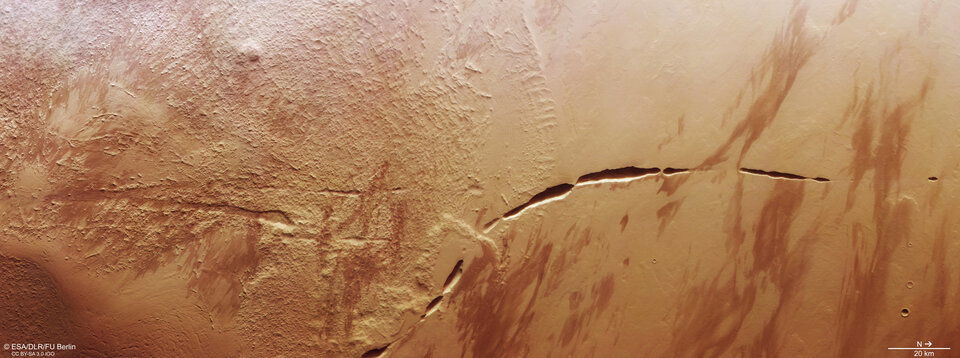Striking new images obtained by the Mars Express spacecraft have revealed a massive 600-kilometer (373-mile) scar on the surface of Mars.
The feature, formally known as Aganippe Fossa, is a graben that traverses Mars’ Tharsis region. The new images are the latest captured by Mars Express, which has been mapping the surface of the Red Planet from its position in orbit since 2003. It has detected valuable information about minerals and other features of the planetary landscape, as well as information about its atmosphere.
Presently, little is known about the huge scar’s origins, although it is believed to have been formed long ago as magma from beneath the Martian surface created intense pressure that caused the crust to stretch and eventually crack.
The Aganippe Fossa would have had no shortage of magma at the time it was formed, as the feature marks the lower flank of Arsia Mons, one of the Red Planet’s largest volcanoes. At more than 9 km (5.5 miles) in height and 435 km (270 miles) in diameter, Arsia Mons is much larger than Ojos del Salado, the largest dormant volcano on Earth. Another nearby Martian volcano, Olympus Mons, is currently the tallest known in our Solar System.
In recent imagery obtained by the Mars Express’s High-Resolution Stereo Camera (HRSC), the region’s diverse terrain was showcased, revealing several valleys, irregular mounds, and rocky debris around the area’s many cliffs and other features.


The ESA said last week that this diverse region on Mars falls within the bright 100,000-square-kilometer (62,137-mile) area surrounding the base of the Arsia Mons volcano, which scientists believe could be linked to ancient glaciers that were once present on this portion of the Martian landscape.
This lighter region at the base of the volcano, known as its aureole, is mainly present only on the volcano’s northwestern flank. Scientists interpret this to mean that it was probably influenced by prevailing winds that directed the deposition of ice in this area over long periods.
Shaped by windblown dust and sand, today’s volcano and surrounding landscape possess unique striped patterns that formed as darker material from the Martian surface settled over lighter areas. Images from this region also show evidence of lava flows that occurred in the past, during periods when the planet was volcanically active.
Earlier this year, the discovery of another massive volcano in the planet’s Tharsis volcanic province was announced, revealing an ancient volcanic formation that had been hidden in plain sight for decades.
Since 2003, when Mars Express began collecting data, its HRSC has greatly broadened our understanding of such features, revealing the presence of not just “hidden” volcanos but also ancient sinkholes, channels formed by ancient rivers, impact features, tectonic faults, and ancient lava pools.
Over its two-decade mission, Mars Express has helped to greatly expand our understanding of Earth’s nearby planetary neighbor and its rich history, which NASA and its international partners hope may eventually produce evidence of ancient lifeforms on the planet, if not the possibility of simple organisms that may potentially exist there currently.
The European Space Agency (ESA) website has additional information about the unique scarred appearance of the Aganippe Fossa, which can be found here.
Micah Hanks is the Editor-in-Chief and Co-Founder of The Debrief. He can be reached by email at micah@thedebrief.org. Follow his work at micahhanks.com and on X: @MicahHanks.

